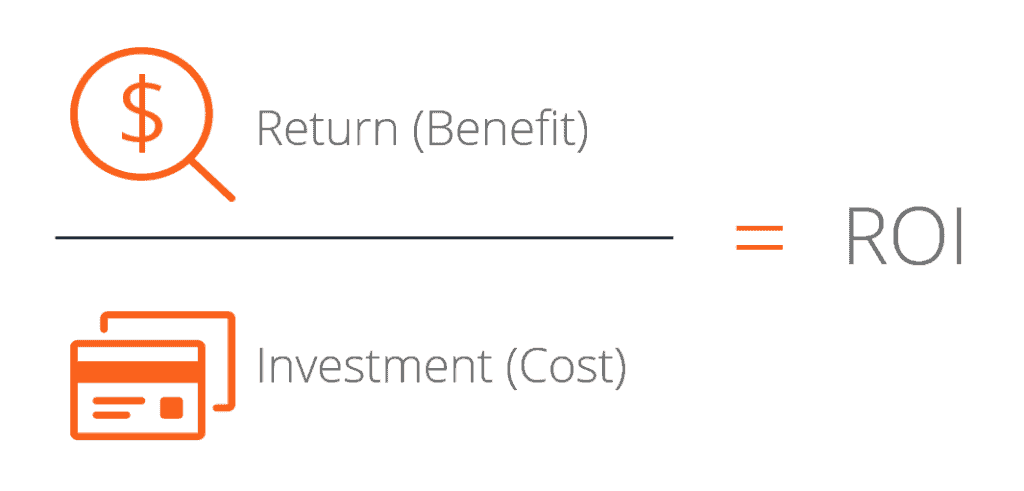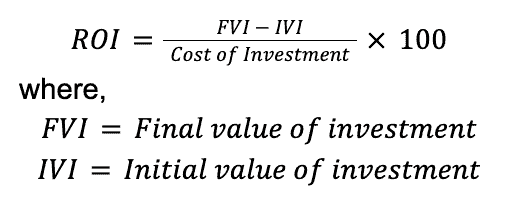Many people automatically think of profit when they are asked how well a company is doing financially. However, profit might signify different things depending on what factors are used while determining it. A failed business is one that does not make a profit, regardless of how many clients it has.
The startups, on the other hand, do not necessarily highlight profitability. Indeed, many firms are acquired or go public years later without ever generating profit. This grow-big strategy is not possible for self-funded startups unless they are producing enough money to sustainably fuel expansion.
Irrespective of how you choose to create your company, the leading criteria for every business is achieving a healthy return on investment (ROI) in your startup. So, why you should focus on your return on investment in your startup?
What is Return on Investment?

Return on investment (ROI) is a performance metric that is used to assess the efficiency or profitability of an investment or to compare the efficiency of many investments. ROI attempts to directly assess the amount of return on a certain investment in relation to the cost of the investment. In short, when you make investments into an investment or a company venture, ROI helps you comprehend how much profit or loss your investment has generated.
Return on investment may be conceived of in four different ways, depending on the observer’s viewpoint and objectives.
An Investor
From the point of view of an investor, such as an angel investor, who effectively lends money to the company. In all circumstances, investors anticipate a return on their investment, which is generally in the form of interest or dividends.
The money allotted by the organisation to finance the interest and any other agreed-upon payments to investors is indicated as an expenditure on the cash flow statement and is commonly referred to as a return on investment.
Organisation Itself Is An Investor
When the organisation itself is an investor, lending money to other organisations and/or investing its own cash in interest-bearing bank accounts. The interest earned is also included as a receipt in the ROI section of the cash flow statement.
Performance Of The Organization’s Investments In Capital Equipment
The performance of the organization’s investments in capital equipment such as plants and property. Obviously, an organisation hopes to generate money as a reward for these investments, and the return on capital employed (ROCE) is a measure of its performance. ROCE is one of the financial statistics that are important in assessing return on investment.
Comparative Return On Investment
Last but not least, the issue of comparative return on investment arises during the consideration of capital investment options. There are several approaches for evaluating the relative advantages of various capital investments.
How do you calculate ROI?
There are several methods to determine ROI, one is to divide net profit by total assets, then, multiplied by 100.

The other is by subtracting the initial value of the investment from the final value of the investment (which equals the net return), then dividing this new number (the net return) by the cost of the investment, then finally, multiplying it by 100.

Since it is stated as a percentage, it is possible to compare the efficacy or profitability of various investment options. It is closely connected to metrics such as return on assets (ROA) and return on equity (ROE).
However, while evaluating ROI, additional aspects that may be less prominent, such as time, hidden expenses and fees, and even emotional ones such as stress, must be included. All of these factors might have a big influence on your ROI.
Advantages and Disadvantages of ROI
Here are some advantages and disadvantages that Return of Investment (ROI) can bring:
| Advantages | Disadvantages |
|---|---|
| A better measurement of profitability | Profit is subjective |
| Minimize conflict of interest and achieve goal congruence | Might be incomparable with other companies |
| Acting as a comparative analysis | Encourage management to invest in a short-term project and discourage them from making new investments |
| Breakdown segment or division performance | The time factor is omitted |
Advantages Of ROI
A better measurement of profitability
ROI ties net income to divisional investments, providing a more accurate measure of divisional profitability. All divisional managers are aware that their performance will be reviewed based on how they used assets to generate a profit; this encourages them to make the best use of assets.
It also guarantees that assets are only bought when they are certain to provide profits in accordance with the organization’s policy. As a result, the primary focus of ROI is on the needed amount of investment. A cost-benefit analysis of this sort assists managers in determining the rate of return that could be expected from various investment options.
This enables them to select an investment that will improve both divisional and organisational profit performance while also allowing them to make better use of current investments.
Minimize conflict of interest and achieve goal congruence
The greater the interest rate, the larger the company’s return. Using it as a tool to analyse investment ideas ensures that management will operate in the best interests of the company. It helps to ensure that both the company and its managers have the same goal in mind: to enhance shareholder value.
As a result, ROI guarantees goal congruence among the various divisions and the company. Any rise in divisional ROI will result in an increase in the overall ROI of the company.
Acting as a comparative analysis
ROI may also be used to compare the profitability and asset utilisation of different business divisions. It can be utilised for inter-firm comparisons if the businesses whose results are being compared are of comparable size and in the same industry, where the management will be able to benchmark the ratio in the market. ROI is a useful metric since it can be easily compared to the associated cost of capital when deciding on investment options.
Breakdown segment or division performance
Using ROI allows the organisation to examine the performance of a division or area. Based on the prospective earnings or growth, they will be able to determine whether to sell or extend the operation of such business units.
From an investment perspective, ROI is important in assessing performance which focuses on maximising profits and making sound judgments about the acquisition and disposal of capital assets.
Disadvantages Of ROI
Accounting profit can be very subjective
Profit can be manipulated by accounting policy and management judgment as they can reduce depreciation expenses by establishing an extended usable life in order to increase profit. Other than that, they will grant a lower allowance for the bad debt even if it is not reasonable.
Might be incomparable with other companies
It will also be challenging to compare ROI with other companies due to variances in accounting policy in each organisation. As we can see from the preceding statement, profit might vary depending on the firm. It is the same as investment cost, and some may use original investment, but others may use net book value, fair value, and so on.
Encourage management to invest in a short-term project and discourage them from making new investments
Only short-term ROI will have an influence on their current performance, whereas long-term projects take too long to provide results. Thus, there will be a higher chance that the management will sacrifice the company’s long-term benefits even if certain projects generate higher returns.
The same goes for when new investments are made, the current ROI will decrease investment in a new IT system, fixed asset, factory, and product line will unlikely generate profit in the short term. However, if we do not complete them on time, the company would face a significant problem that will even impact the company.
The time factor is omitted
When calculating ROI, each project term is completely discarded in favour of focusing solely on the return. It will take a longer period of time to archive a greater return. When the time value of money is considered, a highly profitable enterprise may turn out to be less profitable.
How Do You Use ROI in Your Business?
ROI calculation provides several benefits, but how? What is the first and most obvious? Understanding the impact of your investment on your business. If you discover that you are spending money on an expense, it is obvious that something has to be changed. Many different forms of ROI may assist you in making key business choices, including, but not limited to:
- Purchasing a new asset: Adding new tools, equipment, and goods to your business may be a good thing, but they must be chosen intelligently. Determining the ROI on an equipment purchase enables you to ascertain the cost of your new item and what sorts of equipment to invest in in the future.
- Hiring new staff: Is your new staff improving or lowering the profitability of your company? Monitoring your staff’s ROI will help you better identify the kind of individuals to employ (or fire).
- Having a new department: Adding a new department to your company, like employing new staff, may be wise if it helps raise profitability. You might not want to make assumptions here; compute return on investment to measure the profitability of your departments and uncover chances for improvement.
- Sales strategies: Did a certain tactic contribute to a sale? Tracking which kind of sales methods produce results will offer you an idea of how to enhance your company’s profitability.
Conclusion
Know your figures since utilising ROI to evaluate an investment is a fine place to start, but don’t stop there. Even though companies at the idea stage might be unpredictable, keep in mind that development is the accumulation of modest moves ahead.
You can safely gauge your progress and the needed investment when you focus on a few steps at a time. However, ROI cannot be the only indicator used by investors to make decisions because it does not account for risk or time horizon and necessitates a precise measurement of all expenses.